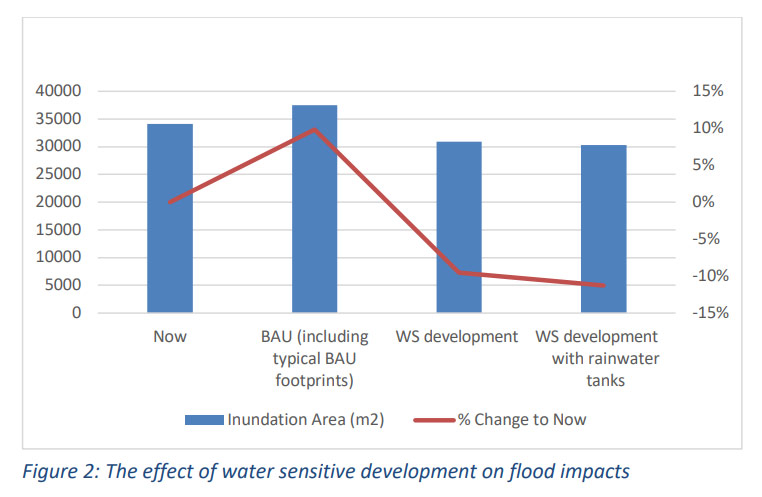Brisbane infill integrated water management system
Contact
Insight:
PROJECT DESCRIPTION
- Existing development or EX represents the existing housing stock. Typical streetscapes and building developments include mostly single houses with relatively generous greenspace around them and strongly vegetated verges.
- Business as usual or BAU is the development that could be expected to occur under current planning instruments, and generally in accordance with best practice. Typically, BAU development comprises low rise multi-unit development with little green space.
- Water sensitive city or WSC development changes the urban design and the way we deal with water in the landscape and for servicing development.
This exploratory work aimed to shape engagement and discussion with industry. It is preliminary and more detailed work is necessary to gain a higher degree of certainty about the outcomes.
THE DRIVERS
Infill development, using efficient design strategies, presents an opportunity to transition towards water sensitive city outcomes. Design led development can yield more outdoor space, valuable stormwater infiltration and tree canopy area. Well planned infill development can generate higher quality outdoor space and optimise resources, eventually reducing overall water and energy demand per dwelling/person. In addition, climate sensitive urban design can be applied to mitigate increases in urban heat associated with higher urban density. However, current or ‘business-as-usual’ (BAU) infill development demonstrates poor water and thermal performance as a result of the low site usability and overall performance. Large building footprints and low-rise developments result in residual and often unusable open spaces, with inadequate tree canopy cover and cross-ventilation, and poor solar access.
THE INNOVATIONS
- Idea 1: Development typologies – New infill development adopts WSC urban design and architectural typologies.
- Idea 2: Enhanced overland flow corridors – New development adjacent to waterways and overland flow drainage paths is arranged to enhance and provide more space for water flows.
- Idea 3: Rainwater and stormwater harvesting – New development includes the storage and reuse of rainwater or stormwater with target storage of about 64 cubic metres per ha.
- Idea 4: Urban cooling – Road and frontage development includes mandatory Water Smart street trees. Development lots include mandatory trees with a target tree cover of approximately 140 trees per ha. The reuse potential of rainwater and stormwater to irrigate the trees and surrounding vegetated areas is maximised.
- Idea 5: Development value activation – Brisbane City Council develops a strategy to activate and share the values with stakeholders captured by a water sensitive cities approach.
THE OUTCOMES
- A significantly higher potential development yield. The WSC approach will support 5,320 people, compared with 2,670 people under the existing scenario and 4,380 people under the BAU approach.
- A lower fraction of impervious surface (about 9% lower for WSC than for BAU), which reduces urban heat island effects, reduces stormwater runoff (which improve waterway health), creates more cool spaces and allows more space for green infrastructure.
- Improved flood and overland flow outcomes. For a 50-year average recurrence interval (ARI) storm event, an estimated 34,100 sqm of land experiences overland flow flooding in the existing scenario. Under WSC development, this area is reduced by 11% to 31,000 sqm, while BAU development increases the flooded area by 10% to 37,500 sqm.
- Reduced per capita water demand and new opportunities for alternative water sources for irrigation of green areas. Alternative water can be sourced from harvesting rainwater and stormwater. Irrigating green areas, street trees, verges etc. is known to improve property values, and help manage urban heat.
These results were incorporated into a benefit–cost analysis (BCA) using the INFFEWS Benefit: Cost Analysis Tool and the Value Tool. This analysis indicated:
- a positive benefit-cost ratio (BCR) of about 2 for the overall project, underpinned by a significant economic benefit accruing to the development industry
- a positive BCR of about 1.3 for Brisbane City Council
- Further, development revenue must fall by 23% to shift the BCR to an unfavourable position (less than 1).
Project stats
Location
Brisbane, Qld, Australia
Dates
2020–2021
Participants
Topics
Contact
Interested in this solution?
We partner with small and large companies, government and industry in Australia and around the world.


Comments